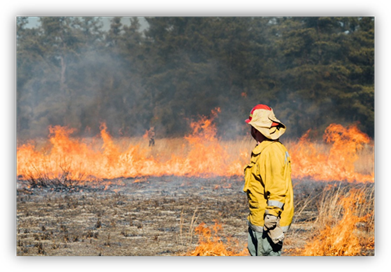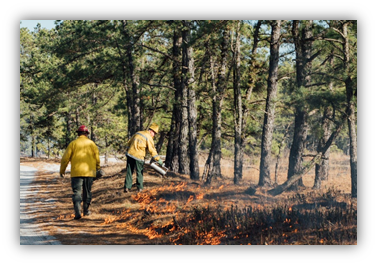NEW JERSEY STATE FOREST FIRE SERVICE PRESCRIBED BURNING PROGRAM
IS UNDERWAY TO HELP REDUCE WILDFIRE RISK
(19/P009) TRENTON – The State Forest Fire Service is setting prescribed burns to reduce undergrowth and other forest floor materials that have the potential to fuel wildfires, the New Jersey Department of Environmental Protection announced today.
Last summer Governor Phil Murphy signed into law “The Prescribed Burn Act,” which preserved landowners’ rights to prescribed burns, strengthened protections for practitioners, and expanded acceptable uses of prescribed fire from reducing traditional hazard fuels to recognizing the benefits of habitat management as well as other forestry and ecological needs.
Forest Fire Service personnel use best management practices and follow a plan to control smoke impacts during the burns, but nearby residents and visitors should expect to see large plumes of smoke and may experience temporary impacts from smoke.
 Motorists are also reminded to use caution when approaching areas where prescribed burns are taking place, by observing posted reduced speed limits, and being alert to the presence of trucks and Forest Fire Service personnel. Motorists are also reminded to use caution when approaching areas where prescribed burns are taking place, by observing posted reduced speed limits, and being alert to the presence of trucks and Forest Fire Service personnel.
“Since 1906, the Forest Fire Service has protected property, lives and infrastructure by creating defensible space and strategic fire breaks near developed areas,” said Greg McLaughlin, Chief of the New Jersey Forest Fire Service. “These prescribed burns help prevent wildfires, reduce the intensity of these fires, and provide a foundation for safer, more effective fire suppression and protection operations.”
Prescribed burns, also known as controlled burns, will continue if weather conditions are appropriate. The burns are generally conducted during late winter months to reduce the amount of smoke produced and because weather conditions tend to be more predictable for safer controlled fires.
The State Forest Fire Service works to provide as much public notice as possible on the areas where prescribed burns are to take place. To sign up for text or email notifications of prescribed burns, visit https://public.govdelivery.com/accounts/NJDEP/subscriber/new.
When in doubt about the source of smoke or if a fire is part of a prescribed burning operation, call 9-1-1 or 1-877-WARN-DEP (1-877-927-6337).  “A safe and effective method of burning away materials that can fuel wildfires, prescribed burns can also help keep forest ecosystems healthy by improving wildlife habitats, managing competing species of plants and trees, controlling insects and disease, and recycling important nutrients into the soil,” said Ray Bukowski, Assistant Commissioner for Natural and Historic Resources. “A safe and effective method of burning away materials that can fuel wildfires, prescribed burns can also help keep forest ecosystems healthy by improving wildlife habitats, managing competing species of plants and trees, controlling insects and disease, and recycling important nutrients into the soil,” said Ray Bukowski, Assistant Commissioner for Natural and Historic Resources.
Prescribed burns help reduce forest fire risk before prime wildfire season, which is typically in April and May in New Jersey. At that time of year fallen leaves, branches and twigs are abundant, daylength increases, humidity can be low, and it is often warm and windy. These weather conditions coupled with lack of new leaf growth makes forest debris more susceptible to the drying effects of wind and sun.
Wildfires can have the greatest impact in areas where people live in or near forests, grasslands and other natural areas. The sprawling Pinelands region in southern New Jersey is especially prone to wildfires because its ecosystem has adapted to depend on periodic wildfires for releasing of seeds for reproduction. Controlling the buildup of fuel in this region helps keep the forest healthy.
During prescribed burns, Forest Fire Service personnel use handheld torches to set smaller fires to burn away fallen leaves, pine needles, fallen branches and other debris on the forest floor. Personnel consider wind, moisture and other conditions in setting the fires, which influence a burn’s intensity and severity to accomplish various resource and ecological objectives such as hazard fuel reduction and habitat management.
This season, the Forest Fire Service expects to conduct prescribed burns on approximately 35,000 acres. Most burns will occur on state-owned property such as state forests, parks and wildlife management areas, and other government lands. The service also will place increased focus on assisting private landowners and nonprofit organizations mitigate wildfire risk.
In 2018, the Forest Fire Service responded to 629 wildfires, most of which were one acre or smaller. The largest was a 901-acre fire in Penn State Forest, Burlington County.
The public may contact one of the State Forest Fire Service’s three Division office at www.nj.gov/dep/parksandforests/fire/contactus.html to learn more about the prescribed burns program and where burns are expected to be conducted.
To learn more about wildfires in New Jersey, steps to protect property, and other resources, visit www.njwildfire.org.
###
DEP Photos: James Douglas
|